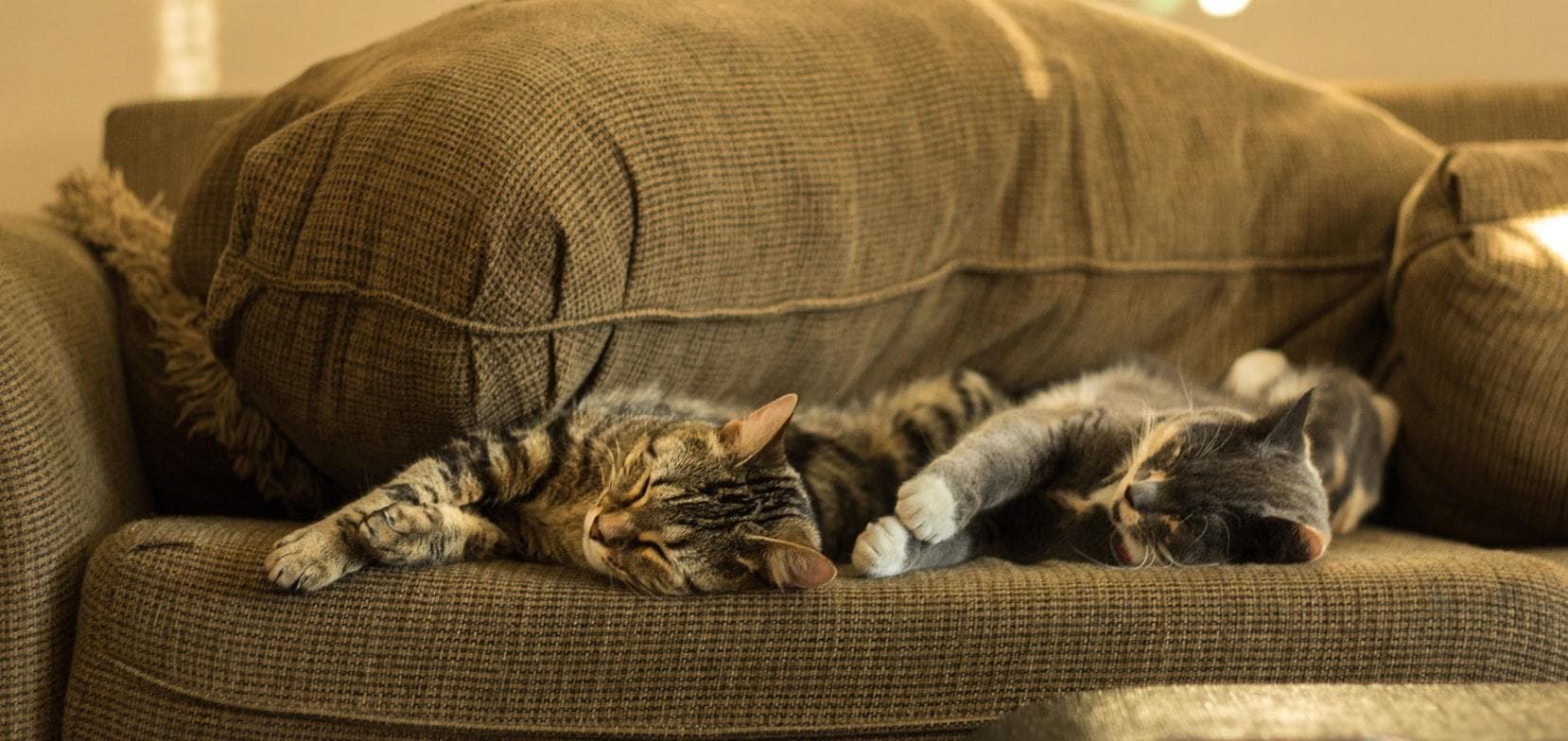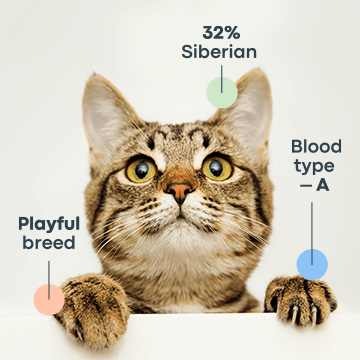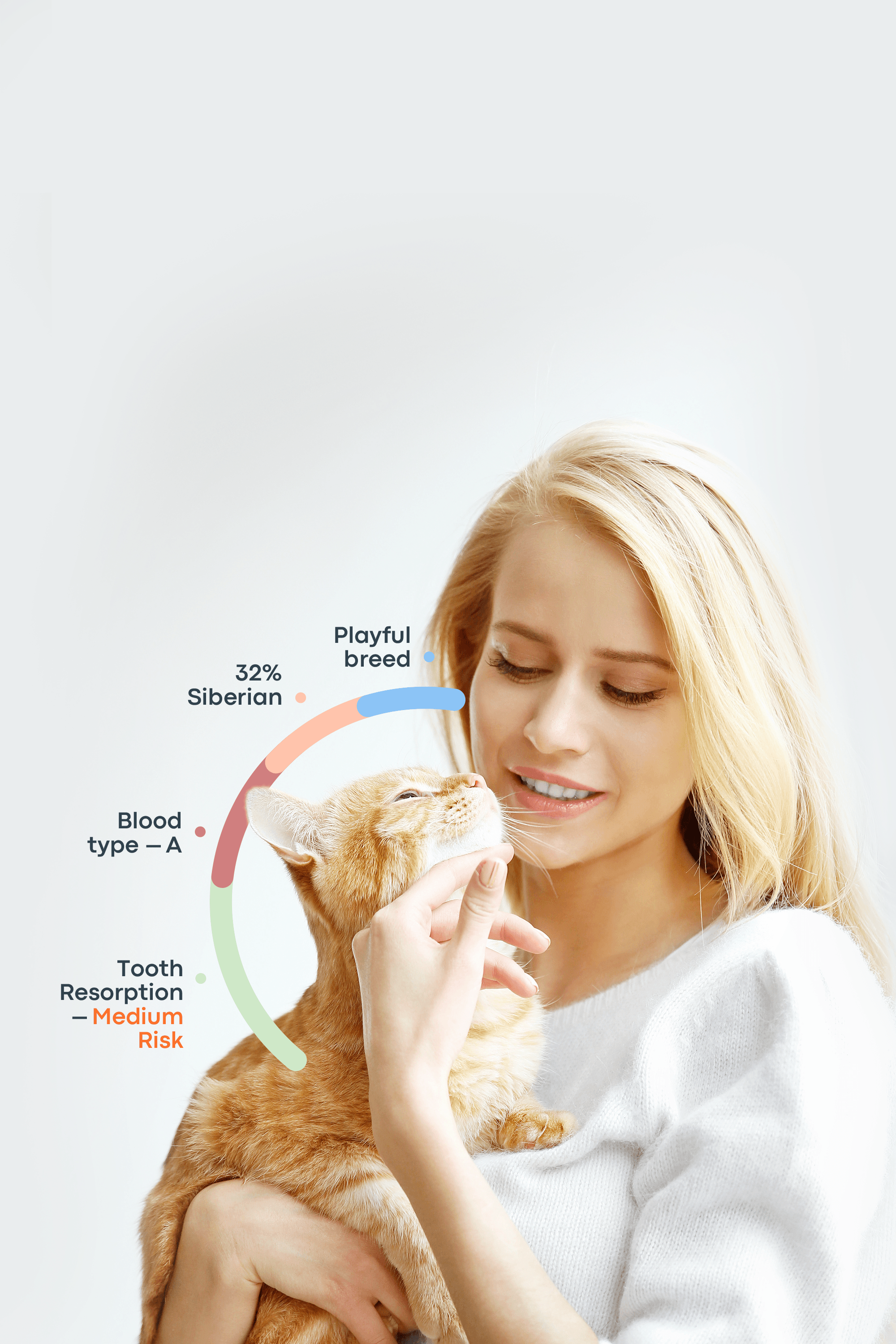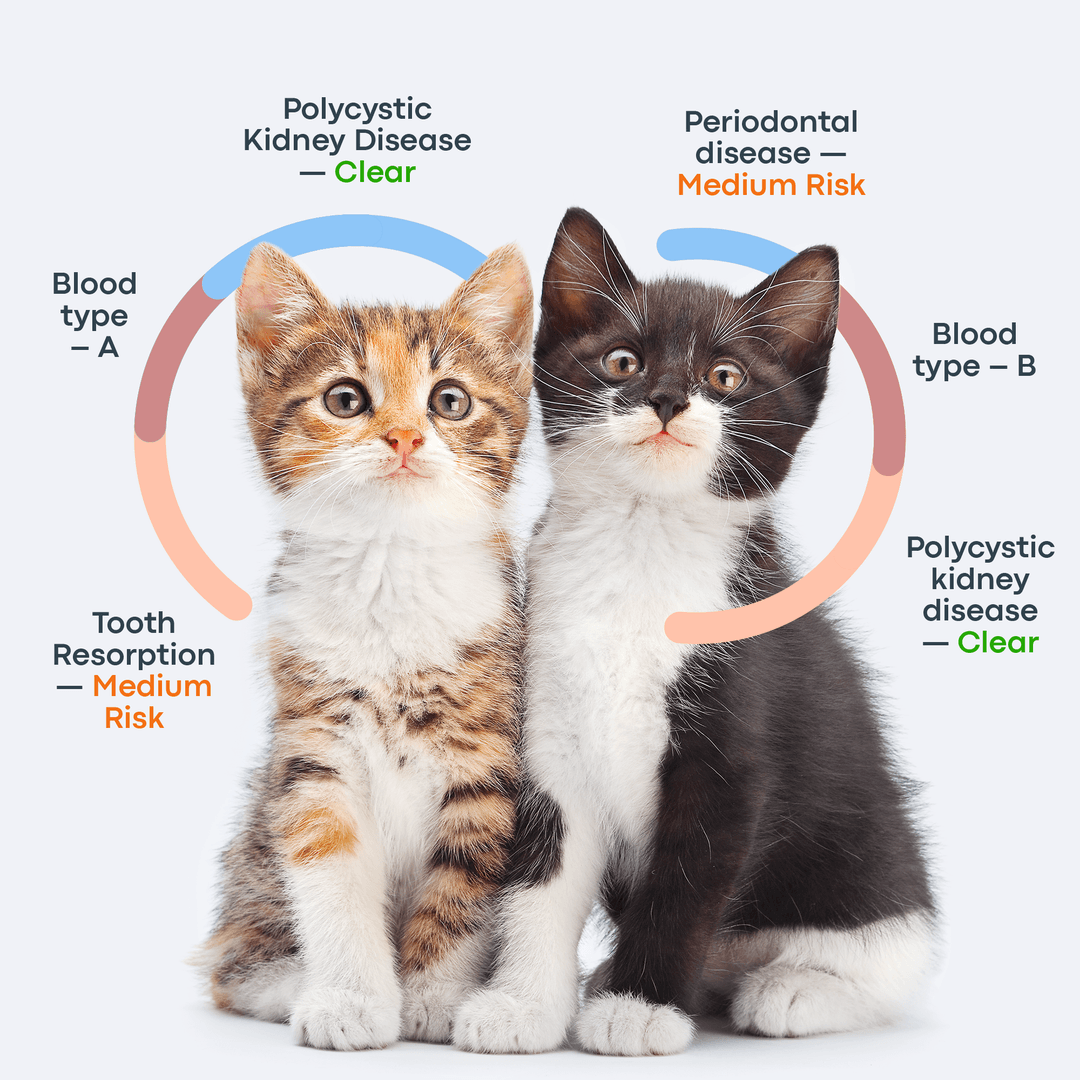We love pawsome cat cuddles as much as you do, so we decided to dig into why some cats seem to be cuddlier than others, and what the benefits of cuddling with your cat are. So, whether you have your furry feline on your lap or on your laptop, sit back, relax, and learn a few things about cat cuddles with Basepaws!
Why Do Cats Cuddle?
Cats have curled up with their favorite humans for centuries—but have you ever wondered why your cat enjoys cuddling so much? In short, it makes them feel warm, safe, and emotionally secure. And your kitty definitely knows it. Here are three big reasons why snuggling is high on your cat’s priority list:
1. Warmth
If your cat is always on the lookout for a sunny nap spot (think windowsills, patches of sunlight on the floor, or even your warm laptop), it’s no coincidence. Maintaining body temperature takes energy, and cats instinctively seek cozy spots. But nothing beats the warmth of another furry friend—or their favorite human.

2. Safety and Protection
Cuddling is an instinct rooted in kittenhood. Baby kittens sleep in tight bundles with their littermates for warmth and security. Many cats carry this behavior into adulthood, seeking out the same feelings of comfort and safety. That’s why your lap—or snuggling close to your neck—can feel like the safest place in the world to your cat.
Fun fact: behaviors like kneading, purring, rubbing, and cuddling are kitten behaviors that stick around for life. They’re comforting, familiar, and deeply instinctual.
3. Bonding with You
For cats, cuddle time is bonding time. They depend on you for food, shelter, and love—and cuddling is one of the sweetest ways they express their affection. Those headbutts, soft purrs, and gentle snuggles? They're all signs that your kitty adores you.
Most cats cuddle simply because they want to be close. And let’s be honest—it’s often just as comforting for us as it is for them. Giving your cat time, attention, and love through cuddles is one of the best ways to strengthen your bond.
Why Are Some Cats More Cuddlier Than Others?
While cuddling is a comforting behavior rooted in kittenhood, not every cat is a snuggler. Some are naturally more independent or reserved—and that’s completely normal. One of the biggest factors influencing how cuddly a cat becomes is early socialization, especially during kittenhood. Genetics may also play a role, but there's still much to learn about how deeply it affects feline affection levels.
The Role of Genetics
Feline genetics is a growing area of research, and while it may influence traits like sociability or temperament, personality is not entirely determined by DNA. Every cat is unique—with their own mix of quirks, comfort levels, and bonding styles. Nurture (how a cat is raised and socialized) often plays just as strong a role as nature.
Cuddliest Cat Breeds
That said, certain breeds are more likely to exhibit cuddly, affectionate behavior. If you’re looking for a lap-loving companion, these breeds are often considered the most snuggly:
Learn more in Basepaws' blog on the top ten most cuddly cats.
It’s important to remember that every cat is an individual, and many complex factors influence their personality. While certain breeds are more likely to produce affectionate, cuddly cats, breed alone doesn’t guarantee a specific temperament. Instead, it simply increases the likelihood that a cat may lean toward being more (or less) affectionate. Nurture, environment, and early experiences all play a big role too.

Early Socialization
While genetics may influence a cat’s potential for being affectionate, early socialization plays a far more critical role in shaping a cat’s personality. The first few months of a kitten’s life are a vital window for social development, and every experience during this time leaves a lasting impact.
Kittens who are gently handled, positively reinforced, and regularly engaged in play during this sensitive period are more likely to grow into confident, social, and emotionally resilient adult cats. These cats tend to explore more, adapt faster, and handle stress more effectively.
In contrast, kittens that lack proper socialization or face traumatic experiences early on are more likely to develop fearful or avoidant behaviors. As adults, they may be shy, cautious, or even reactive. This is why early social development is a major factor in determining how cuddly and comfortable a cat will be around people later in life.
Why Some Cats Don’t Like to Cuddle
PetMD claims that all felines have different social levels. All felines have varying social needs—not every cat is naturally cuddly, and that’s perfectly normal. Some simply prefer their independence, while others may have experienced trauma or overstimulation that makes them wary of close contact. Like people, cats have unique personalities, comfort levels, and boundaries.
A cat walking away isn’t rejecting you—it’s just expressing what feels safe. The key is patience. Offer gentle affection when your cat approaches and always let them set the pace. Over time, even a more reserved cat may grow more open to closeness. A calm, consistent environment can also go a long way in building trust and reducing stress.
Cat Body Language Signs
Body Language | Wants to Cuddle | Wants Space |
Tail Position | Tail upright with a soft curve | Tail flicking or lashing rapidly |
Ears | Ears forward or slightly relaxed | Ears flattened back or sideways |
Eyes | Slow blinking, soft gaze | Wide eyes with dilated pupils |
Purring | Deep, rhythmic purr while relaxed | Purrs paired with tension or agitation |
Kneading | Gently pushing paws into your lap or blanket | Tense paws or sudden stiffening |
Body Posture | Curled up close, relaxed muscles | Body stiffening, attempting to pull away |
Head Movements | Head bunting or nudging | Head turning away or avoiding eye contact |
Vocalizations | Soft meows or trills | Growling, hissing, or yowling |
Approach Behavior | Jumps into lap or rubs against you | Hides, backs away, or avoids contact |
Other Ways Your Cat Can Show You Love
Not all cats cuddle, but that doesn’t mean they don’t adore you. Felines have their own unique ways of expressing affection—and once you know what to look for, you’ll spot the signs everywhere. Here are some subtle (and not-so-subtle) ways your cat may be saying “I love you”:
Giving you soft, slow blinks—often called “kitty kisses”
Rubbing their face against your legs to mark you as part of their territory
Dropping toys or little “gifts” at your feet (yes, even the ones from outdoors!), according to Zoetis
Following you from room to room like a furry little shadow
Choosing to nap near you, even if not directly on your lap
Purring contentedly when you’re not actively petting them
Kneading their paws on your lap, chest, or favorite blanket
Waiting at the door when they hear you coming home
Benefits of Cats Cuddling

Benefits for you
Reduces stress and supports heart health: Petting a purring cat can help lower blood pressure and decrease cortisol levels.
Boosts oxytocin: This “feel-good” hormone promotes bonding, trust, and emotional comfort.
Eases anxiety and helps lift low moods: The calm presence of a cat can bring mental clarity and ease symptoms of depression.
Strengthens your emotional bond: Regular cuddle time builds a deeper connection between you and your feline companion.
Encourages relaxation: Just a few minutes of quiet time with your cat can reset your mood and help you unwind.
Benefits for your cat
Promotes a sense of safety and trust: Cuddling helps your cat feel emotionally secure and strengthens their attachment to you.
Helps with body temperature regulation: Cats love warmth, and your lap is a perfect cozy spot.
Reduces stress: Physical affection helps soothe anxiety and can calm an overstimulated kitty.
Reinforces your bond from their point of view: Affectionate touch tells your cat they’re loved and safe.
Supports immune health: Studies suggest that reduced stress in pets can lead to better immune system function.
What Science Says About Cat Cuddling
Cuddling doesn’t just feel good—it’s backed by science. Physical affection, like hugging or petting, is known to benefit both mental and physical health. For humans, comforting touch helps release oxytocin, often called the “love hormone” or “bonding chemical.” This hormone lowers stress, eases anxiety, and combats loneliness.
Surprisingly, cats benefit in similar ways.
A 2014 study by Gourkow et al. observed 139 shelter cats split into two groups:
One group was “gentled”—they were petted and spoken to for at least 10 minutes, four times daily. Even the initially fearful cats received calm, consistent interaction using soft-handling techniques.
The other group received no extra attention or affection—similar to what many shelter or stray cats experience daily.
The results were powerful:
Cats in the gentled group became calmer over time and showed increased levels of immunoglobulin A, an important antibody that helps fight illness.
In contrast, the control group showed more signs of stress, with many cats shedding excessively or developing respiratory issues.
The takeaway? Gentle, positive touch is more than just a nice gesture—it actively supports your cat’s physical health and emotional well-being.
The Healing Power of Purring
According to journalist Kelli Bender, studies have shown that a cat’s purr vibrates between 20 and 140 Hz—a frequency range associated with healing in both humans and animals.
When your cat purrs while snuggling with you, it can help:
Lower your stress and anxiety
Stabilize your blood pressure
Improve respiratory comfort (especially for those with shortness of breath)
Ease symptoms of low mood or depression
For cats themselves, purring may do even more. Experts believe it helps:
Heal injuries faster
Promote muscle and tendon recovery
Support bone health through low-frequency vibrations
In other words, your cat’s purr isn’t just soothing—it’s scientifically therapeutic. So the next time your feline friend curls up and starts purring, know that healing is happening on both ends of the cuddle.

How to Encourage Your Cat to Cuddle You More
Let them come to you first
Cats value independence and like to feel in control of their space. Instead of reaching out, sit nearby and allow them to approach on their own terms. A quiet moment—reading a book or sipping tea—can be the perfect setting to let them make the first move.
Create warm, cozy spots
Comfort is key. Add a soft blanket or cushion near where you usually relax. Cats are drawn to warmth, so consider sitting by a sunny window or placing a heating pad nearby. Stay still and patient—this invites them in and helps them feel safe.
Try slow blinking
Establish trust with the slow blink—a cat’s version of a smile. Make gentle eye contact, then slowly close your eyes and look away. If your cat blinks back, they’re showing trust. Repeat this to help build a sense of calm and emotional connection.
Pet them where they like it
Most cats enjoy being petted on the cheeks, behind the ears, or under the chin. Avoid touching their belly or tail unless you’re sure they like it. Pay attention to what makes them relax or purr.
Keep your movements soft and calm
Fast or sudden movements can startle your cat. Move slowly, speak softly, and keep your tone gentle. Avoid loud noises or quick gestures, which can interrupt the bonding moment.
Reward closeness
When your cat chooses to sit near you or cuddle, reinforce that behavior. Offer gentle head pats, soft praise, or even a favorite treat. This positive reinforcement helps them associate cuddling with comfort and safety.
Respect their boundaries
Trust is built through patience. If your cat walks away or shows signs of discomfort, don’t force interaction. Learning to read their signals will deepen your connection over time. Watch for signs your cat doesn't want to cuddle:
Flattened ears
Tail flicking or thumping
Sudden grooming or yawning
Growling, hissing, or walking away
Skin twitching or tensing
Keep the environment calm
Cats are most relaxed in peaceful surroundings. Keep background noise low—soft music or muted TV is fine, but avoid sudden loud sounds. A tranquil space creates opportunities for quiet connection.
Use familiar scents
Familiar smells mean safety to cats. According to the Feline Conservation Fund, they can smell 14 times better than people. Your clothes are ideal for this. Strong perfumes or unfamiliar cleaning products do not work well. Let them sniff and rub against your clothes.
Letting your cat cuddle on their own terms builds lasting trust. With consistency, warmth, and respect, even a more reserved cat may start to seek you out for those quiet, heartwarming moments.
Get to Know Your Cat Better with Basepaws
As a loving cat parent, you want to know everything you possibly can about your furry feline friend. Basepaws gives you the opportunity to do just that with our Breed + Health Cat DNA Test. Learn about the genetics behind your cat's unique breed profile, health, and appearance. Just one test unlocks important information that will help you proactively care for your cat's health and everyday needs. You don’t want to miss out on an opportunity to become a well-informed cat parent and do everything you can to cuddle with your cat for many years to come!
Frequently Asked Questions
Why do cats cuddle with each other?
They cuddle to keep warm and form bonds with each other.
What is the best way to cuddle your cat?
Wait for them to come to you. Stroke them gently and don’t try to force them to cuddle.
Do cats enjoy cuddling or are they just in it for the warmth?
Most felines do, but some might not. It can be a way to stay warm or simply to show trust.
Do cats cuddle with people they just met?
Depending on the nature of the cat, it varies. Some instantly take to strangers and might cuddle. Others take their time warming up.
Can cats be cuddled too much?
There is always the possibility. Often children end up cuddling cats way too much. Always be alert to signs that they are enjoying the cuddle.
What is the reason behind cats snuggling up to one person and ignoring others?
The person’s energy can be behind this. Some people give off calming energy, which is attractive for cats.




